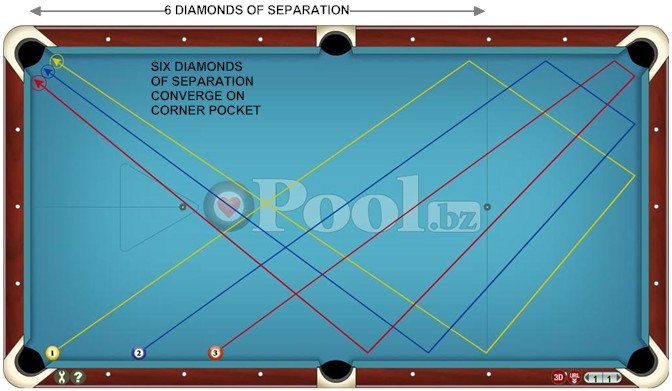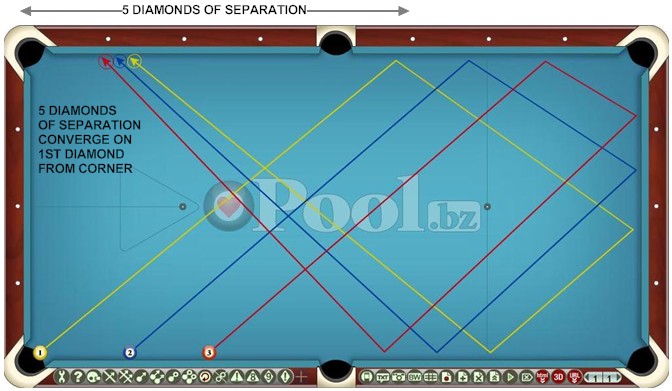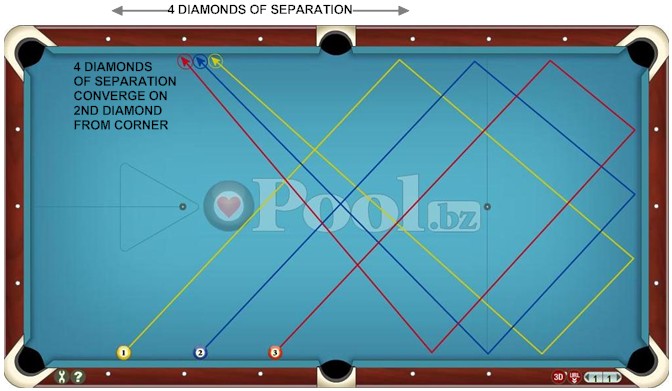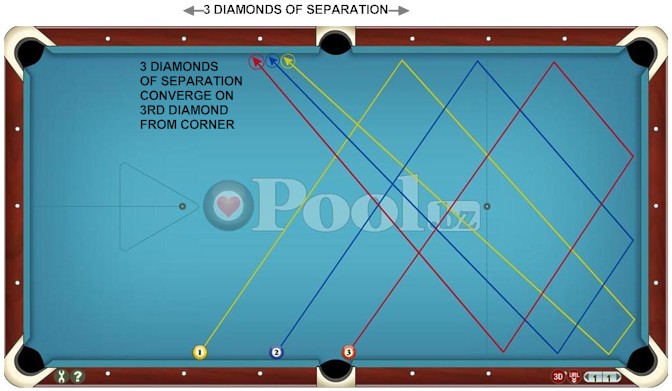How does the “Corner-5” System work?
It is illustrated and explained, with examples, in the Corner-5 system handout and in the following articles:
- “VEPS GEMS – Part XI: Corner-5 System Intro” (BD, November, 2010).
- “VEPS GEMS – Part XII: Corner-5 System Example and Benchmark” (BD, December, 2010).
- “VEPS GEMS – Part XIII: Corner-5 System Adjustments” (BD, January, 2011).
Here are complete demonstrations, explanations, and examples of the Corner-5 system, the 2nd video from Vol. IV of The Video Encyclopedia of Pool Shots (VEPS):
Another interesting and entertaining demonstration of the system can be found in Disney’s “Donald in Mathmagic Land” (starting at the 16:47 point).
And interesting visual alternative to the Corner-5 system is the “spot on the wall” system.
Is there a system for aiming multiple-rail kicks, hitting a short rail first?
Yes. The Plus System works well for two- and three-rail kicks.
For four-rail kicks, see the following video from Michael Isbell (also see the video description in YouTube which provides a detailed explanation):
from Patrick Johnson:
[Here’s] a simplified way to estimate 3-rail kicks to given targets on the fourth rail. This simplified 3-rail kick system is vaguely similar to the Spot-On-The-Wall system and the Corner-Five system, but instead of off-table visual references (Spot-On-The-Wall) or math (Corner Five), it uses simple diamond-to-diamond alignments.
Three rail kicks that start out parallel to each other (their first legs are parallel) end up hitting the fourth rail very close together – they “converge” on a fourth rail target. It’s easy to see parallel lines on the pool table using the diamonds. If we start with a line stretched between one diamond on the near long rail and another diamond on the far long rail, we can simply move each end of the line one diamond to the right to find a parallel line. Move each end another diamond in the same direction (left or right) and there’s another parallel line, etc. The angle of these parallel lines between the diamonds is determined by how many diamonds along the rail one diamond is from the other – call this their “separation”. For instance, diamonds on opposite long rails with “4 diamonds of separation” make parallel lines at 45° (see third diagram below), while diamonds with “3 diamonds of separation” make parallel lines at 51° (see fourth diagram below).
Using these easy-to-see diamond-to-diamond lines, we get sets of parallel lines to use as reference tracks for 3-rail kicks. Fortunately for us, each set of parallel lines converges near a pocket or diamond on the fourth rail, making both our first legs and our fourth rail targets easy to remember. The correlations are:
– a first leg line with 6 diamonds of separation will come close to the corner pocket on the fourth rail
– a first leg line with 5 diamonds of separation will come close to the 1st diamond on the fourth rail
– a first leg line with 4 diamonds of separation will come close to the 2nd diamond on the fourth rail
– a first leg line with 3 diamonds of separation will come close to the 3rd diamond on the fourth rail
Below are diagrams illustrating these basic reference tracks:
Use a “6-diamond separation” to hit the corner pocket on the 4th rail.

Use a “5-diamond separation” to hit the 1st diamond on the 4th rail.

Use a “4-diamond separation” to hit the 2nd diamond on the 4th rail.

Use a “3-diamond separation” to hit the 3rd diamond on the 4th rail.

from AtLarge:
I think this will be extremely easy to remember. Notice that for each of the cases you cited, the number of diamonds of separation plus the 4th-rail convergence diamond (counting from the pocket as zero) totals 6. That is, 6+0=6. 5+1=6. 4+2=6. 3+3=6. So we could call it the “Sixes System” for three-rail kicks.
Dr. Dave keeps this site commercial free, with no ads. If you appreciate the free resources, please consider making a one-time or monthly donation to show your support:
